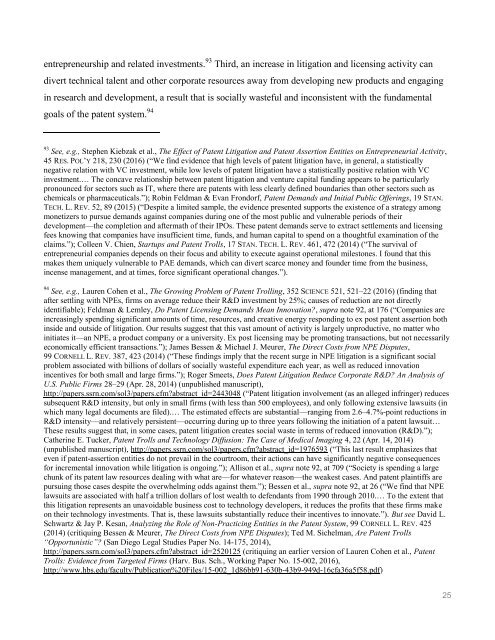Create successful ePaper yourself
Turn your PDF publications into a flip-book with our unique Google optimized e-Paper software.
entrepreneurship and related investments. 93 Third, an increase in litigation and licensing activity can<br />
divert technical talent and other corporate resources away from developing new products and engaging<br />
in research and development, a result that is socially wasteful and inconsistent with the fundamental<br />
goals of the patent system. 94<br />
93<br />
See, e.g., Stephen Kiebzak et al., The Effect of <strong>Patent</strong> Litigation and <strong>Patent</strong> <strong>Assertion</strong> Entities on Entrepreneurial <strong>Activity</strong>,<br />
45 RES. POL’Y 218, 230 (2016) (“We find evidence that high levels of patent litigation have, in general, a statistically<br />
negative relation with VC investment, while low levels of patent litigation have a statistically positive relation with VC<br />
investment.… The concave relationship between patent litigation and venture capital funding appears to be particularly<br />
pronounced for sectors such as IT, where there are patents with less clearly defined boundaries than other sectors such as<br />
chemicals or pharmaceuticals.”); Robin Feldman & Evan Frondorf, <strong>Patent</strong> Demands and Initial Public Offerings, 19 STAN.<br />
TECH. L. REV. 52, 89 (2015) (“Despite a limited sample, the evidence presented supports the existence of a strategy among<br />
monetizers to pursue demands against companies during one of the most public and vulnerable periods of their<br />
development—the completion and aftermath of their IPOs. These patent demands serve to extract settlements and licensing<br />
fees knowing that companies have insufficient time, funds, and human capital to spend on a thoughtful examination of the<br />
claims.”); Colleen V. Chien, Startups and <strong>Patent</strong> Trolls, 17 STAN. TECH. L. REV. 461, 472 (2014) (“The survival of<br />
entrepreneurial companies depends on their focus and ability to execute against operational milestones. I found that this<br />
makes them uniquely vulnerable to PAE demands, which can divert scarce money and founder time from the business,<br />
incense management, and at times, force significant operational changes.”).<br />
94<br />
See, e.g., Lauren Cohen et al., The Growing Problem of <strong>Patent</strong> Trolling, 352 SCIENCE 521, 521–22 (2016) (finding that<br />
after settling with NPEs, firms on average reduce their R&D investment by 25%; causes of reduction are not directly<br />
identifiable); Feldman & Lemley, Do <strong>Patent</strong> Licensing Demands Mean Innovation?, supra note 92, at 176 (“Companies are<br />
increasingly spending significant amounts of time, resources, and creative energy responding to ex post patent assertion both<br />
inside and outside of litigation. Our results suggest that this vast amount of activity is largely unproductive, no matter who<br />
initiates it—an NPE, a product company or a university. Ex post licensing may be promoting transactions, but not necessarily<br />
economically efficient transactions.”); James Bessen & Michael J. Meurer, The Direct Costs from NPE Disputes,<br />
99 CORNELL L. REV. 387, 423 (2014) (“These findings imply that the recent surge in NPE litigation is a significant social<br />
problem associated with billions of dollars of socially wasteful expenditure each year, as well as reduced innovation<br />
incentives for both small and large firms.”); Roger Smeets, Does <strong>Patent</strong> Litigation Reduce Corporate R&D? An Analysis of<br />
U.S. Public Firms 28–29 (Apr. 28, 2014) (unpublished manuscript),<br />
http://papers.ssrn.com/sol3/papers.cfm?abstract_id=2443048 (“<strong>Patent</strong> litigation involvement (as an alleged infringer) reduces<br />
subsequent R&D intensity, but only in small firms (with less than 500 employees), and only following extensive lawsuits (in<br />
which many legal documents are filed).… The estimated effects are substantial—ranging from 2.6–4.7%-point reductions in<br />
R&D intensity—and relatively persistent—occurring during up to three years following the initiation of a patent lawsuit…<br />
These results suggest that, in some cases, patent litigation creates social waste in terms of reduced innovation (R&D).”);<br />
Catherine E. Tucker, <strong>Patent</strong> Trolls and Technology Diffusion: The Case of Medical Imaging 4, 22 (Apr. 14, 2014)<br />
(unpublished manuscript), http://papers.ssrn.com/sol3/papers.cfm?abstract_id=1976593 (“This last result emphasizes that<br />
even if patent-assertion entities do not prevail in the courtroom, their actions can have significantly negative consequences<br />
for incremental innovation while litigation is ongoing.”); Allison et al., supra note 92, at 709 (“Society is spending a large<br />
chunk of its patent law resources dealing with what are—for whatever reason—the weakest cases. And patent plaintiffs are<br />
pursuing those cases despite the overwhelming odds against them.”); Bessen et al., supra note 92, at 26 (“We find that NPE<br />
lawsuits are associated with half a trillion dollars of lost wealth to defendants from 1990 through 2010.… To the extent that<br />
this litigation represents an unavoidable business cost to technology developers, it reduces the profits that these firms make<br />
on their technology investments. That is, these lawsuits substantially reduce their incentives to innovate.”). But see David L.<br />
Schwartz & Jay P. Kesan, Analyzing the Role of Non-Practicing Entities in the <strong>Patent</strong> System, 99 CORNELL L. REV. 425<br />
(2014) (critiquing Bessen & Meurer, The Direct Costs from NPE Disputes); Ted M. Sichelman, Are <strong>Patent</strong> Trolls<br />
“Opportunistic”? (San Diego Legal Studies Paper No. 14-175, 2014),<br />
http://papers.ssrn.com/sol3/papers.cfm?abstract_id=2520125 (critiquing an earlier version of Lauren Cohen et al., <strong>Patent</strong><br />
Trolls: Evidence from Targeted Firms (Harv. Bus. Sch., Working Paper No. 15-002, 2016),<br />
http://www.hbs.edu/faculty/Publication%20Files/15-002_1d86bb91-630b-43b9-949d-16cfa36a5f58.pdf)<br />
25


